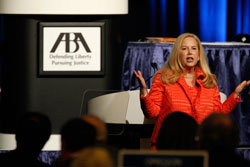House of Delegates supports key measure to fight human trafficking

Outgoing ABA President Laurel G. Bellows: “The uniform act is a critical step because it outlines an approach to dealing with human trafficking that can be applied consistently by jurisdictions throughout the country.” Photo by Tony Avelar.
The ABA House of Delegates has approved a uniform law that could become an important weapon in the war against human trafficking in the United States.
The 560-member House, which sets policy for the ABA, approved the Uniform Prevention of and Remedies for Human Trafficking Act (PDF) in August “as an appropriate act” for adoption by states during its sessions at the association’s 2013 annual meeting.
The National Conference of Commissioners on Uniform State Laws, which also identifies itself as the Uniform Law Commission, took on the task of drafting the act in 2010 at the urging of the ABA Center for Human Rights. The ULC’s drafting committee worked closely with the center—as well as the ABA Task Force on Human Trafficking, the Section of Business Law and a number of other groups—in developing the uniform act. The ULC approved the final version of the act in July.
“The uniform act is a critical step” because it outlines an approach to dealing with human trafficking that can be applied consistently by jurisdictions throughout the country, said outgoing ABA President Laurel G. Bellows, whose one-year term ended at the close of the meeting. “If adopted, it will create a floor of legislation across state lines,” said Bellows, who is principal of the Bellows Law Group in Chicago, in an interview with the ABA Journal.
Raising awareness about human trafficking and looking for more effective responses to it by the justice system has been at the top of Bellows’ agenda throughout her presidential year, and she continued to hammer away at the issue in San Francisco. Trafficking was a prominent topic, for instance, in her speeches at the opening assembly and to the House of Delegates.
“We started with a lack of knowledge at the ABA that mirrored a lack of knowledge generally about the problem of human slavery,” Bellows told the Journal. “But there’s been a great jump in awareness. We began a national awareness campaign so that in short order every American will understand the scope of the issue.”
WORTHY GOALS
The statistics describing the scope of the problem are dramatic and daunting. The U.S. Department of State estimates in its Trafficking in Persons Report for 2012 that some 27 million women, children and men are enslaved around the world, primarily in various forms of sexual exploitation or forced labor. The State Department and some nongovernmental organizations estimate the number of human trafficking victims in the United States at some 100,000. “By 2012, human trafficking had become the second-fastest-growing criminal activity in the United States, following drug trafficking,” states a report submitted to the House of Delegates by the Uniform Law Commission. Children are “roughly one-half of the victims of this $32 billion ‘industry,’ according to the National Human Trafficking Resource Center and others.”
One key goal of the uniform act is to bring greater consistency to the treatment of human trafficking at the state level. “While every state has laws regarding human trafficking, these laws vary greatly in both substance and scope,” states the ULC’s report to the House.
A second goal of the act is to encourage states to treat human trafficking laws as more than just criminal measures. The uniform act also includes provisions for victim services and remedies, and the creation of coordinating bodies to oversee support services for victims and promote public awareness.
Developing effective support services for trafficking victims is crucial, said Jimmy K. Goodman, a director at Crowe & Dunlevy in Oklahoma City who co-chairs the ABA’s Human Trafficking Task Force with Linda C. Hayman, who is of counsel at Skadden, Arps, Slate, Meagher & Flom in New York City. “People who are disconnected from everything except their chains need to find their way back to society,” Goodman said. “Providing support services helps give victims a chance to feel like real people again.”



